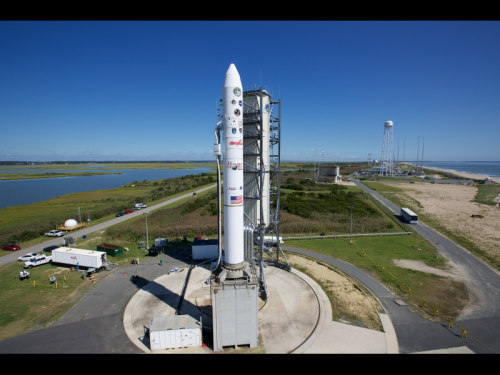LADEE Poised for Liftoff Tonight
NASA’s LADEE, Lunar Atmosphere and Dust Environment Explorer mission stands poised for liftoff aboard an Orbital Sciences Minotaur V launch vehicle from pad 0B at the Mid-Atlantic Regional Spaceport at 11:27 p.m. EDT this evening.
With the near midnight flight expected to be visible from much of the U.S. East Coast, it is likely to receive more media attention than would otherwise be expected. The LADEE spacecraft was designed and built in house by NASA’s Ames Research Center at Moffett Field Ca. to study the Moon’s extremely tenuous atmosphere before future landers and further human activity muck it up beyond its current, mostly “pristine” state.
According to NASA “The LADEE spacecraft makes use of general purpose spacecraft modules that allow for a plug-and-play approach to manufacturing and assembly. This approach along with commercial off-the-shelf products allows mission designers to develop, assemble and test multiple spacecraft modules at the same time – essentially giving them the versatility to get the biggest bang for NASA’s buck.”
Of particular note on the subject of costs is the row which was kicked up in 2009, when NASA assigned the LADEE launch to Orbital Sciences and the Minotaur V, which will be the vehicle’s maiden flight. The 5 stage Minotaur V is based on the 4 stage Minotaur IV, buts adds a fifth and final stage, the Star 37M, to achieve lunar performance. Both share in common the first three stages adapted from the Peacekeeper ICBM’s. SpaceX protested the original award, arguing that it violated the 1998 Commercial Space Act, which generally prevents the conversion of ICBM’s into commercial space launchers on the grounds that doing so harms new launch development efforts. There are several exceptions to the act, one of which being if NASA determined that a commercial launcher was not available for an equivalent price. The LADEE mission is one of those exceptions, and the protest was denied.
One interesting angle to the complaint, particularly considering OSC’s frequent use of the term “low cost” to describe the launch, was that NASA did not take into account the full costs of the roughly $46 million dollar award, because it neglected to include the original cost of the ICBM derived components, even though it did include the $27 million award from the Air Force to OSC, for converting those components.
No matter how you count it, and even if you consider the $27 million to basically acquire the same thing for a second time a bargain, the entire affair demonstrates just how far we have yet to go in achieving truly “low cost” access to space. Given the fact that the Google Lunar X-Prize is having serious challenges in keeping teams in the running, with much of the trouble stemming from the costs of space launch, LADEE may have more time available for study than we might hope.



“….NASA did not take into account the full costs of the roughly $46 million dollar award, because it neglected to include the original cost of the ICBM derived components, even though it did include the $27 million award from the Air Force to OSC, for converting those components.”
Just to clarify. NASA did not give the contract to SpaceX for a $56.5million F9 launch. They gave it to Orbital at $46million, because they forgot/neglected/chose not to take into account the original $27million conversion costs. So the real cost to the US taxpayer was $73million.
So, there are two ways to look at this depending on ones preferred point of view. Either you could say that the $27million had already been spent, so using those components on a useful launch vehicle validated that original expenditure. Or, you could say, that by not giving the contract to Spacex, $16.5 million was pissed away for no good reason.
From a NASA budget point of view, they saved $10.5million, from a US taxpayer point of view $16.5million was wasted (although presumably decommissioning and disposing of the the ICBM would have had some cost to it anyway).
I must have sobered temporarily and re-read the article. So the $46million did include the $27million?, but not whatever the original cost of the ICBM components?. I seem to have ranted too soon, but it’s not entirely clear. What is the actual “real” cost of the Minotaur V?, if known.